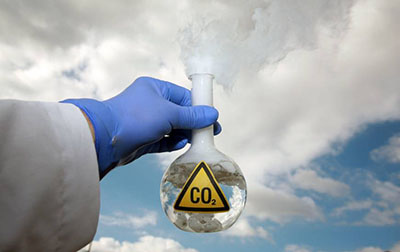

 |
 |
|
|||||||||||||
 GCEP Quarterly Newsletter
Newsletter Sign-Up
News Archive
GCEP Quarterly Newsletter
Newsletter Sign-Up
News Archive
|
Carbon mitigation is about exergy, not energy New analysis shows big benefits of carbon capture and storage technologies. By Miles Traer 
With global carbon dioxide levels recently passing 400 parts per million and carbon emissions projected to continue rising in the coming decades, scientists are working hard to find ways to remove the greenhouse gas from the atmosphere and bury it underground. The process is called carbon capture and storage (CCS), and its critics claim that it uses up so much energy that it offsets any benefits gained from removing the carbon dioxide. But according to Stanford’s Adam Brandt, energy is the wrong way to analyze the benefits of CCS. We should be looking at “exergy.” Brandt presented his research at the Annual Global Climate and Energy Project (GCEP) Research Symposium October 14, hosted by GCEP Director Sally Benson. Brandt was one of several speakers who addressed the topic of carbon mitigation. A professor of Energy Resources Engineering at the School of Earth, Energy & Environmental Sciences, Brandt studies life cycle analysis, a method to estimate all of the materials and energy used to create a product or extract resources and transform them into useful electricity. “Giga-ton scale deployment of CCS, the amount necessary to significantly combat global climate change, would require economy-wide shifts in material and energy flows,” Brandt said. “And the best way to quantify the benefits of CCS is by looking at exergy, not energy.” Exergy vs EnergyExergy is a cousin of energy. Informally, exergy is the useful part of energy – what gets consumed to do work. But unlike standard energy analysis, exergy provides a number that can be compared across many different systems, including electricity production and waste streams. For decades, exergy has been proposed as a metric of environmental impact because it measures the potential for a pollutant to drive changes in its surroundings. But to date, exergy analysis had not been fully combined with life cycle analysis. 
Adam Brandt, assistant professor of Energy Resources Engineering
Brandt recently investigated the benefits of CCS deployed at a coal power plant. “Using traditional techniques, we see that the required exergy for CCS at a coal-fired power plant jumps dramatically. It is such a rise that we would have to expend 50 units of natural resource exergy just to reduce one unit of pollution. At first glance, this looks pretty bad,” said Brandt. But there is a problem with traditional exergy analysis when used in systems that involve climate change. Traditional exergy analysis assumes that damage from pollution occurs as a pollutant reacts and disperses into a large, static “reference environment.” As Brandt explained, “Exergy analysis requires an unchanging environment. But global carbon emissions are changing our climate. So we have to rethink exergy in this context to include long-term impacts from carbon dioxide after it spreads into the atmosphere.” Brandt comically mused that coming up with a set of equations to describe the thermodynamics of a changing climate system could be one of the most difficult problems in the world to solve. But based on research by Ken Caldeira, a Stanford Earth professor and senior scientist for Stanford’s Carnegie Institution, and postdoctoral student Xiaochun Zhang, Brandt was able to generate a first assessment of long-term exergy impacts to better analyze CCS. “When we account for the changing climate system, investing exergy resources to capture carbon dioxide reduces exergy flows to future human and biosphere systems 600 times over,” Brandt said. “This is much better than the previous analysis would suggest.” As CCS technology continues to develop and more groups find ways to deploy it at scale, Brandt says that analysts should all spend a little more energy looking into the benefits by accounting for the changing climate. Or, maybe more appropriately, they should spend a little more exergy. This article was originally published by the Stanford School of Earth, Energy & Environmental Sciences. October 26, 2015 |
| Restricted Use of Materials from GCEP Site: User may download materials from GCEP site only for User's own personal, non-commercial use. User may not otherwise copy, reproduce, retransmit, distribute, publish, commercially exploit or otherwise transfer any material without obtaining prior GCEP or author approval. |